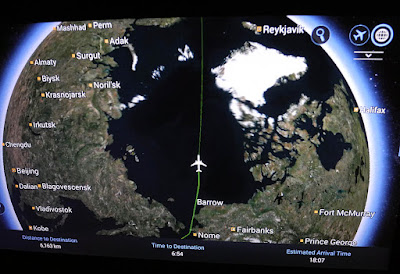Then I get it. The next-best way back to Europe, if geopolitical factors obtrude, is over the North Pole. And so it turns out. We make a beeline, or more probably a great circle route, directly for the Bering Straits. Before we get there, the light fades through an abbreviated afternoon into an accelerated sunset. Then we turn due north, hugging the Alaskan coast.
In the event, we skirt the North Pole itself by some hundreds of kilometres. A little later, the polar night lightens enough for a long dark rift to appear in the undercast below – no, that’s not cloud but a lead of dark water in the drifting ice pack. The glimpse recalls Fridtjof Nansen’s Fram expedition, on a ship that was designed to drift across the arctic embedded in the pack-ice.
Of course, Nansen didn’t quite make it to the pole either, giving up his bold foray from the ship at 86 13.6′ North in April 1895. But what a vintage year for exploration that was. In August, Alfred Mummery vanished into thin air, in an attempt to ascend Nanga Parbat that was about a century before its time.
And in December, the meteorologist Nonaka Itaru and his wife Chiyoko were rescued from their pioneering midwinter sojourn on top of Mt Fuji. They too were far ahead of their era, for nobody else would attempt to emulate their feat until well into the following century.
The thought of that icy vigil prompts me to look at the flight display again – as we approach northeastern Greenland, the outside air temperature falls to minus 63⁰C. Not to worry, though, we should still have a few degrees in hand before the jet fuel starts to freeze. Now that really would be yabai....



1 comment:
Good to see I'm not the only one who enjoyed flying this route to Europe. Sadly, for me, cloud obscured the interesting parts of the globe below, until the last 50 miles or so of north east Greenland.
Post a Comment